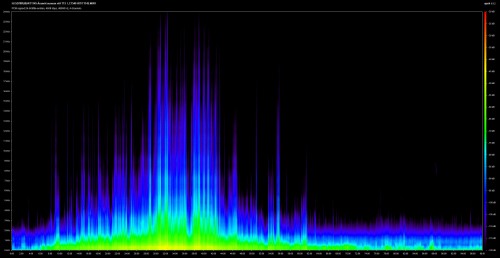Recording fireworks is probably like photographing a sunset for a photographer. Nothing special but there is always some duty that calls for it to be done.
It is not the loud sound that fascinates, but the interaction of the sound with the environment. Reflection of a sound wave. e.g. the echoes from houses, mountains or trees that make it interesting to record fireworks. The problem, however, is that I am often confined to staying at home with my family on this day. I am therefore not in different places from year to year, and therefore I have to say that I have not made a good or interesting recording of fireworks, apart from maybe one recording in Tenerife. I’m also always experimenting with microphone setups, which usually don’t work out well when there’s a lot of other things going on.
It is with mixed feelings that I put a fireworks recording on the web this time. Have done it before and therefore not urgent to do it again because it always sounds as a loud noise which is not healthy for the ears or speakers.
But this new year is marked by terrible wars, which unfortunately all have their origins to the western hegemony and imperialism, as usual. Most recently with the targeted genocide in Palestine which as of this writing can easily escalate into an even bigger war, more or less all over the middle east.
The NATO proxy war in Ukraine is still going on after almost ten years conflict. It has destroyed Ukraine and seems to be also destroying Europe in coming years, if not in decades because of politicians stupidity. This time, the West, led by the United States, EU & GB has lost both credibility and the trust of most nations in the world.
The world is changing. US unipolar empire is falling and new multipolar empires are rising. At the same time, the US will drag Europe down in the fall and destroy Europe as a flourishing continent, only because of insane hatred towards Russia.
The new year therefore does not seem to offer anything good for many nations, but only continued with conflict and disaster. Fireworks with all its noise are therefore no longer part of entertainment in my mind, but a reminder of war with destruction, killings and mutilations.
This recording was made in my backyard, between houses with LCT540s in IRT. You can hear that the echo time is short. Some might think it’s because I used a Limiter. But the Limiter was turned off, as always should be done when recording fireworks. Recording sound pressure rose to a peak of +7.7dB (-7.4 LUFS-S) .
Details that can often be heard in fireworks when they are launched are not heard clearly in this recording because they were launched from beyond the houses in this backyard. However, I had another microphone set (MKH20/40 parallel AB) close to a place where people were setting off fireworks, but that recording did not go well for various reasons.
Even though this recording has been downgraded to mp3, be careful when listening to this recording. Don´t put up the volume, especially not when listening with speakers.
Quality open headphones are recommended while listening at mid/high-level.
Following picture shows the spectrogram of the whole recording this new years eve. But following recording start at 22:30min. Midnight is at 30:00min and the recording end at 52:30min
If the media player doesn’t start to play, please reload this individual blog in a new tab or frame.
(mp3 256kbps / 67Mb)
Recorder: Sound devices 788
Mics: Lewitt 540s, IRT cross setup
Weather: Calm, about -4°C
Pix: Spek Spectrogram
Location: Reykjavik Iceland









